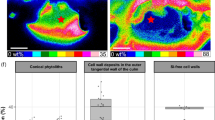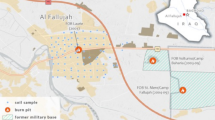Abstract
We reconstructed the contamination history of an area influenced by 40 years of uranium mining and subsequent remediation actions using dendroanalysis (i.e., the determination of the elemental content of tree rings). The uranium content in the tree rings of four individual oak trees (Quercus sp.) was determined by laser ablation with inductively coupled plasma mass spectrometry (LA-ICP-MS). This technique allows the investigation of trace metals in solid samples with a spatial resolution of 250 μm and a detection limit below 0.01 μg/g for uranium. The investigations show that in three of the four oaks sampled, there were temporally similar uranium concentrations. These were approximately 2 orders of magnitude higher (0.15 to 0.4 μg/g) than those from before the period of active mining (concentrations below 0.01 μg/g). After the mining was terminated and the area was restored, the uranium contents in the wood decreased by approximately 1 order of magnitude. The similar radial uranium distribution patterns of the three trees were confirmed by correlation analysis. In combination with the results of soil analyses, it was determined that there was a heterogeneous contamination in the forest investigated. This could be confirmed by pre-remediation soil uranium contents from literature. The uranium contents in the tree rings of the oaks investigated reflect the contamination history of the study area. This study demonstrates that the dendrochemical analysis of oak tree rings is a suitable technique for investigating past and recent uranium contamination in mining areas.




Similar content being viewed by others
References
Anderson S, Chappelka AH, Flynn KM, Odom JW (2000) Lead accumulation in Quercus nigra and Q. velutina near smelting facilities in Alabama, USA. Water Air Soil Pollut 118:1–11. doi:10.1023/a:1005138313978
Aznar JC, Richer-Lafleche M, Begin C, Rodrigue R (2008) Spatiotemporal reconstruction of lead contamination using tree rings and organic soil layers. Sci Total Environ 407:233–241. doi:10.1016/j.scitotenv.2008.09.044
Baltrenas P, Vaitkute D (2011) Investigation and evaluation of copper and zinc concentration tendencies in Pinus sylvestris L. tree-rings. J Environ Eng Landsc Manag 19:278–286. doi:10.3846/16486897.2011.634418
Bindler R, Renberg I, Klaminder J, Emteryd O (2004) Tree rings as Pb pollution archives? A comparison of Pb-206/Pb-207 isotope ratios in pine and other environmental media. Sci Total Environ 319:173–183. doi:10.1016/s0048-9697(03)00397-8
Cheng Z, Buckley BM, Katz B, Wright W, Bailey R, Smith KT, Li J, Curtis A, Geen A (2007) Arsenic in tree rings at a highly contaminated site. Sci Total Environ 376:324–334. doi:10.1016/j.scitotenv.2007.01.074
DIN ISO 19730 (2009) Soil quality—extraction of trace elements from soil using ammonium nitrate solution. Deutsches Institut für Normung e.V
Dybczynski R, Polkowska-Motrenko H, Samczynski Z, Szopa Z (1998) Virginia tobacco leaves (CTA-VTL-2)—new Polish CRM for inorganic trace analysis including microanalysis. Fresenius J Anal Chem 360:384–387. doi:10.1007/s002160050718
Eckelmann W, Ad-hoc Arbeitsgruppe Boden (2006) Bodenkundliche kartieranleitung - KA5, vol 5. Schweizerbart Science Publishers, Stuttgart
Edmands JD, Brabander DJ, Coleman DS (2001) Uptake and mobility of uranium in black oaks: implications for biomonitoring depleted uranium-contaminated groundwater. Chemosphere 44:789–795. doi:10.1016/s0045-6535(00)00376-3
Federal Ministry of Economics and Technology, Becker J, Ruhrmann G, Wismut GmbH (2011) 20 Years Wismut GmbH—remediation for the future. Federal Ministry of Economics and Technology (BMWi). http://www.bmwi.de/English/Redaktion/Pdf/20-years-wismut-gmbh,property=pdf,bereich=bmwi2012,sprache=en,rwb=true.pdf. Accessed 10/08 2014
Fisher S, Nicholas NS, Scheuerman PR (2002) Dendrochemical analysis of lead and calcium in southern Appalachian American beech. J Environ Qual 31:1137–1145. doi:10.2134/jeq2002.1137
Galicki SJ, Davidson GR, Threlkeld ST (2008) Element mobility in bald cypress xylem. Tree-Ring Res 64:39–46. doi:10.3959/2007-7.1
Greger M (2004) Metal availability, uptake, transport and accumulation in plants. In: Prasad MNV (ed) Heavy metal stress in plants. Springer, Berlin, pp 1–27. doi:10.1007/978-3-662-07743-6_1
Hagemeyer J (1993) Monitoring trace metal pollution with tree rings: a critical reassessment. In: Markert B (ed) Plants as biomonitors. VCH, Weinheim, pp 541–563
Hagemeyer J (2000) Trace metals in tree rings: what do they tell us? In: Markert B, Friese K (eds) Trace metals in the environment, Elsevier, pp 375–385
Jenk U, Zimmermann U, Uhlig U, Schoepke R, Paul M (2014) In situ mine water treatment: field experiment at the flooded Konigstein uranium mine (Germany). Mine Water Environ 33:39–47. doi:10.1007/s10230-013-0241-9
Kennedy VH, Sanchez AL, Oughton DH, Rowland AP (1997) Use of single and sequential chemical extractants to assess radionuclide and heavy metal availability from soils for root uptake. Analyst 122:89R–100R. doi:10.1039/A704133K
Kötschau A, Büchel G, Einax JW, Mirgorodsky D, Meißner R, von Tümpling W, Merten D (2014) Element contents in shoots of sunflower (Helianthus annuus): prediction versus measuring. Chem Erde - Geochem 74:385–391. doi:10.1016/j.chemer.2014.02.006
Lageard JGA, Howell JA, Rothwell JJ, Drew IB (2008) The utility of Pinus sylvestris L. in dendrochemical investigations: pollution impact of lead mining and smelting in Darley Dale, Derbyshire, UK. Environ Pollut 153:284–294. doi:10.1016/j.envpol.2007.08.031
MacDonald HC, Laroque CP, Fleming DEB, Gherase MR (2011) Dendroanalysis of metal pollution from the Sydney steel plant in Sydney, Nova Scotia. Dendrochronologia 29:9–15. doi:10.1016/j.dendro.2010.08.001
Martin RR, Tomlin A, Marsello B (2000) Arsenic uptake in orchard trees: implications for dendroanalysis. Chemosphere 41:635–637. doi:10.1016/s0045-6535(99)00501-9
Mitchell T, Sandwall P, Rolfes B, Lobaugh M, Bowen J, Elliston J, Glover SE, Spitz HB (2008) Feasibility of using dendroanalysis of uranium as a biomarker for environmental contamination. J Radioanal Nucl Chem 277:223–225. doi:10.1007/s10967-008-0734-3
Monticelli D, Iorio A, Ciceri E, Castelletti A, Dossi C (2009) Tree ring microanalysis by LA-ICP-MS for environmental monitoring: validation or refutation? Two case histories. Microchim Acta 164:139–148. doi:10.1007/s00604-008-0049-7
Nabais C, Freitas H, Hagemeyer J (1999) Dendroanalysis: a tool for biomonitoring environmental pollution? Sci Total Environ 232:33–37. doi:10.1016/s0048-9697(99)00107-2
Pearce NJG, Perkins WT, Westgate JA, Gorton MP, Jackson SE, Neal CR, Chenery SP (1997) A compilation of new and published major and trace element data for NIST SRM 610 and NIST SRM 612 glass reference materials. Geostand Newslett 21:115–144. doi:10.1111/j.1751-908X.1997.tb00538.x
Punshon T, Bertsch PM, Lanzirotti A, McLeod K, Burger J (2003) Geochemical signature of contaminated sediment remobilization revealed by spatially resolved X-ray microanalysis of annual rings of Salix nigra. Environ Sci Technol 37:1766–1774. doi:10.1021/es0261628
Saint-Laurent D, Duplessis P, St-Laurent J, Lavoie L (2011) Reconstructing contamination events on riverbanks in southern Quebec using dendrochronology and dendrochemical methods. Dendrochronologia 29:31–40. doi:10.1016/j.dendro.2010.08.005
Schaumloffel JC, Filby RH, Moore BC (1998) Ponderosa pine tree rings as historical monitors of zinc and cadmium pollution. J Environ Qual 27:851–859
Ulrich A, Barrelet T, Figi R, Rennenberg H, Kraehenbuehl U (2009) Time resolved sulphur and nutrient distribution in Norway spruce drill cores using ICP-OES. Microchim Acta 165:79–89. doi:10.1007/s00604-008-0101-7
Van de Geijn SC, Petit CM (1979) Transport of divalent-cations: cation-exchange capacity of intact xylem vessels. Plant Physiol 64:954–958. doi:10.1104/pp. 64.6.954
Watmough SA (1999) Monitoring historical changes in soil and atmospheric trace metal levels by dendrochemical analysis. Environ Pollut 106:391–403. doi:10.1016/s0269-7491(99)00102-5
Watmough SA (2002) A dendrochemical survey of sugar maple (Acer saccharum Marsh) in South-Central Ontario, Canada. Water Air Soil Pollut 136:165–187
Watmough SA, Hutchinson TC (2003) A comparison of temporal patterns in trace metal concentration in tree rings of four common European tree species adjacent to a Cu-Cd refinery. Water Air Soil Pollut 146:225–241. doi:10.1023/a:1023952417583
Wismut GmbH (ed) (2010) Chronik der Wismut. CD-ROM (in German)
Wright G, Woodward C, Peri L, Weisberg PJ, Gustin MS (2014) Application of tree rings dendrochemistry for detecting historical trends in air Hg concentrations across multiple scales. Biogeochemistry 120:149–162. doi:10.1007/s10533-014-9987-9
Zeien H, Brümmer GW (1989) Chemische extraktionen zur bestimmung von schwermetallbindungsformen in böden. Mitt Dt Bodenkdl Ges 59:505–510 (in German)
Acknowledgments
Many thanks to Georg Büchel and his working group for general support, Anika Kötschau for valuable advice on data analysis and assistance with the LA-ICP-MS system, the Wismut GmbH for data supply, and Gottfried Nosowsky (district forestry officer of the “Reuster Forst”) for supporting the work in the study area.
Compliance with ethical standards
ᅟ
Funding
This study was funded by financial resources of the Friedrich Schiller University Jena (Institute of Geosciences) and without third-party funds.
Conflict of interest
The authors declare that they have no competing interests.
Human and animal rights and informed consent
For this study, no research on humans or animals was performed.
Author information
Authors and Affiliations
Corresponding author
Additional information
Responsible editor: Stuart Simpson
Rights and permissions
About this article
Cite this article
Märten, A., Berger, D., Köhler, M. et al. The dendroanalysis of oak trees as a method of biomonitoring past and recent contamination in an area influenced by uranium mining. Environ Sci Pollut Res 22, 19417–19425 (2015). https://doi.org/10.1007/s11356-015-4902-z
Received:
Accepted:
Published:
Issue Date:
DOI: https://doi.org/10.1007/s11356-015-4902-z




